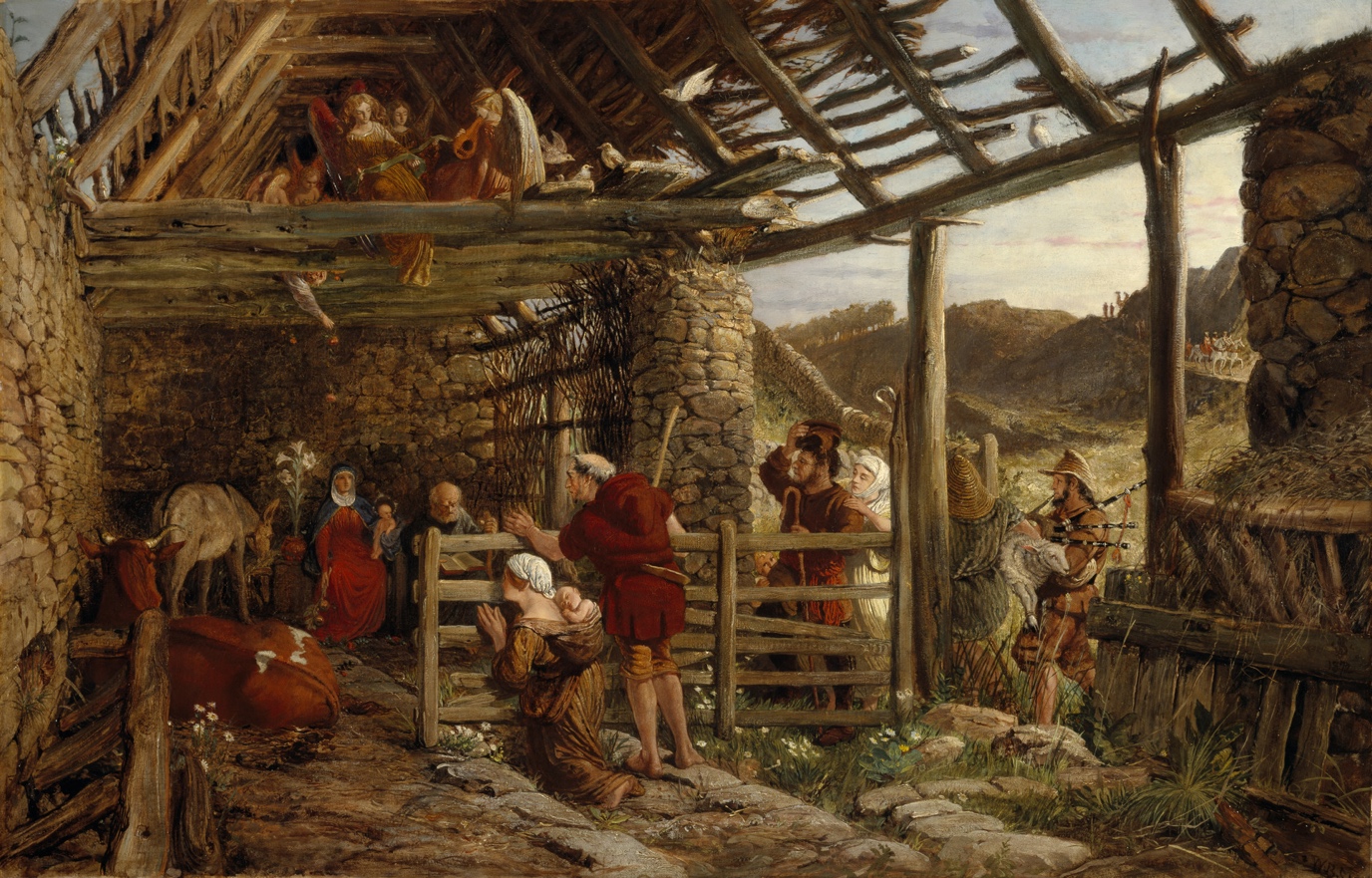Christmas - William Bell Scott: The Nativity
William Bell Scott: The Nativity

A Scottish Nativity
by Linden Bicket
In Scotland, Advent comes with the deepening winter. Darkness lingers long into our mornings and eventually allows a glimpse of pearlescent skies, but by mid-afternoon daylight recedes and night falls quickly again. The Nativity (1872) by the Scottish painter and poet William Bell Scott is a welcome companion during the short winter days of this cold climate. Scott’s painting glows with warmth and hopefulness. It reminds its viewer that despite the gloom of the northern hemisphere, Advent is the season of longing which will eventually culminate in the radiance of ‘the light of the world’ (John 8:12).
In common with the vernacular nativities of the Renaissance, the setting of The Nativity isn’t Bethlehem, but the painter’s own native land, as Dennis T. Lanigan observes. Scott’s nativity takes place in a ramshackle stable near Penkill Castle in Ayrshire. The painter knew this sixteenth-century castle intimately. It was the home of Alice Boyd – an art pupil of his whom he loved – and it appealed to him as a poet as well as a painter. He painted frescoes based on the beautiful fifteenth-century poem The Kingis Quair (attributed to the Scottish King James I) on the castle’s spiral staircase. His pre-Raphaelite circle were also captivated by this place; Scott’s friend Christina Rossetti visited often. Her brother, Dante Gabriel, wrote to Scott on 25th August 1871: ‘I am sorry you do not seem to see your way quite clearly about the Nativity at the old barn, but hope you will yet drop into it.’ Rossetti had already painted his own vibrantly colourful altar-piece Adoration for the interior of Llandaff Cathedral, and wrote to Scott encouragingly a month later on 15th September to say: ‘I am delighted to hear of the progress of the Nativity subject, from which I shall expect real results.’
Although Rossetti’s words suggest that Scott may have struggled initially to capture the subject to his own satisfaction, his finished nativity scene is full of intimate, poignant details that make it deeply touching. The site of Christ’s birth is rendered in warm, inviting tones, but it is anything but lavish. Daisies and dandelions jostle between the rough-hewn slabs of stone that jut out from the earth. The thatch in the roof is sparse in places, and allows full daylight to illuminate the holy family – a stark contrast to other depictions of Christ’s arrival in the pre-dawn. The crowned Magi who can be glimpsed leading a convoy of camels and servants to the scene do not follow ‘a star in the east’ (Matthew 2:2), but travel instead towards the golden glow illuminating the babe-of-Bethlehem’s birthplace.
Many familiar features of nativity art are here. The ox and the ass rest and feed, reminding us that the Christ child is born to be ‘the bread of life’ (John 6:35). Mary, sitting beside the lilies that signal her purity, wears a blue cloak and holds her haloed babe close. Playful angels sing, surrounded by doves in the stable’s rafters, and one reaches down to scatter roses lovingly at the feet of the baby’s mother, the ‘rose without thorns’. Mary holds a branch of apples (as the new Eve), while Joseph, much older, reads intently.
But it’s the Adoration of the Shepherds (and their wives and babies) that gives Scott’s painting such vitality. One shepherd carries the zampogna that features in so many Italian nativity scenes and which (as a type of chanter bagpipe) feels so appropriate to this Scottish painter’s rendering of the Adoration. A woman cranes her neck to see beyond her husband, who gently lifts his cap in reverence. And in the foreground, the stable’s wooden gate functions as a type of altar rail, behind which a shepherd’s wife kneels and clasps her hands in prayer. As I look at this scene, this woman seems to stand for me. The sleeping baby she carries on her back reminds me of the countless times that my own child has fallen asleep in my arms. I know how special this feels, and how sacred. As she carries her own little love, this woman witnesses God’s love incarnate.
Reflection on The Nativity is time well spent. Its tender re-imagining of God made flesh is rich sustenance for the imagination in the midst of winter gloom.
*******
William Bell Scott (1811–1890) was a Scottish painter, poet and art teacher born in Edinburgh. The son of the engraver Robert Scott (1777–1841) and brother of the painter David Scott (1806-1849), he moved to London in 1837, where he became friends with the Rossetti family. He was also associated with the Pre-Raphaelite Brotherhood, and was especially close friends with Dante Gabriel Rossetti. From 1843-1863 he was first master of the School of Design in Newcastle, England. He died at Penkill, Scotland in 1890.
William Bell Scott: The Nativity, 1872; oil on canvas; 74.00 x 114.00 cm; National Gallery of Scotland, Edinburgh.
Linden Bicket is a Lecturer in Literature and Religion in the School of Divinity at the University of Edinburgh and the author of George Mackay Brown and the Scottish Catholic Imagination (Edinburgh University Press, 2017). Her research focuses on Catholic literature and on patterns of faith and scepticism in modern and contemporary writing.
ArtWay Visual Meditation 17 December 2023






